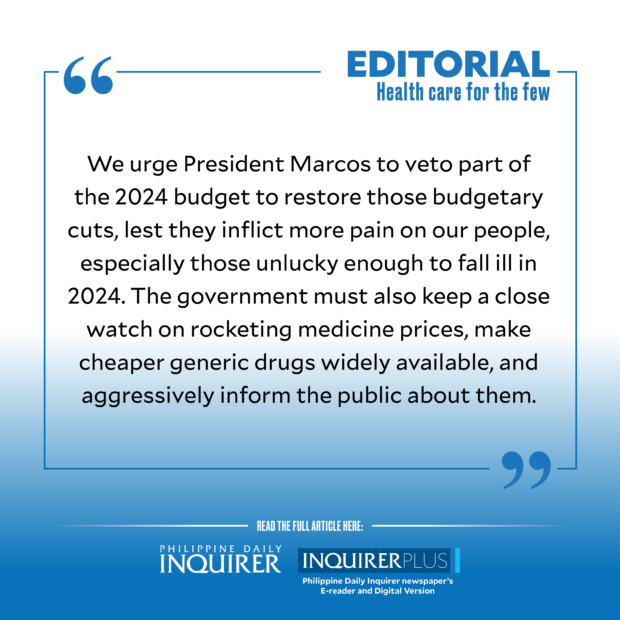Health care for the few

A perpetual torment for working Filipinos today is the thought that they’re just one medical bill away from poverty. Sadly, this anxiety is well-founded, as a World Health Organization (WHO) report has shown that one out of five people in the Philippines and other Western Pacific countries faces “catastrophic” health expenses each year.
“Catastrophic” might sound like an exaggeration to the privileged few who can afford private health insurance or dip into their savings for the occasional medical emergency, but it is all too true that a life-threatening diagnosis or a prolonged hospital stay could be devastating to an ordinary Filipino family with no financial cushion.
Granted, access to essential health services has grown over the past two decades in the region but at a tremendous cost: The proportion of people who have incurred ruinous health expenses has doubled between 2000 and 2017, according to the WHO report released on Dec. 12, in observance of the Universal Health Coverage Day.
Article continues after this advertisementCatastrophic health spending
“In 2000, one in 10 people in the region incurred catastrophic health spending. By 2017, this proportion had increased to one in five, totaling some 385 million people in the Western Pacific,” the report said.
“No person should have to choose between whether to seek life-saving care or to feed their family,” said Dr. Zsuzsanna Jakab, WHO acting regional director for the Western Pacific.
Besides telling us that we are not alone in this predicament, the WHO report only confirms what we already knew: Health care is not for all in the Philippines.
Article continues after this advertisementIn February 2019, then President Rodrigo Duterte signed the Universal Health Care Act, which was supposed to give every Filipino access to comprehensive primary health-care services and benefits, including free consultation, diagnostic tests, and case management.
Under the law, Filipinos are automatically enrolled in the National Health Insurance Program either as direct contributors, who pay health premiums through salary deductions or voluntarily, or indirect contributors, whose premiums are subsidized, like senior citizens or indigents.
Scandal-ridden PhilHealth
The insurance program is administered by the scandal-ridden Philippine Health Insurance Corp. (PhilHealth), which offers the Konsultasyong Sulit at Tama Package to beneficiaries.
In the just ratified 2024 budget, the country’s economic managers had proposed a 1.7 percent increase for PhilHealth, raising its appropriation to P101.5 billion to accommodate a larger pool of members.
But a smaller share was earmarked for direct health services and expansion of health system capacities, as think tank Ibon Foundation noted in September.
“The government is clearly going for a health system that is insurance-driven instead of direct service provisioning,” Ibon said.
In total, only 5.6 percent, or about P325.4 billion of the P5.78 trillion national budget, would go to the health sector next year.
Rocketing medicine prices
To make matters worse, the budgets of specialty public hospitals, such as the Philippine Heart Center, Lung Center of the Philippines, National Kidney and Transplant Institute, and Philippine Children’s Medical Center, suffered cuts as well. To keep themselves afloat, these hospitals “will be more inclined to accept paying patients than indigent patients as such preference will contribute more to their operations funding,” Ibon warned.
It’s bad enough that the Department of Health and PhilHealth are perennially beset with mismanagement and corruption issues, but the meager funding to cover disadvantaged Filipinos’ medical costs rubs salt into the wounds ailing our health sector.
We urge President Marcos to veto part of the 2024 budget to restore those budgetary cuts, lest they inflict more pain on our people, especially those unlucky enough to fall ill in 2024. The government must also keep a close watch on rocketing medicine prices, make cheaper generic drugs widely available, and aggressively inform the public about them.
Medically unattended deaths
In 2022, every Filipino spent P10,059.49 for health-care goods and services, as household out-of-pocket payments accounted for 44.7 percent of health expenditures, practically equal to the share of government health-care programs, according to the Philippine Statistics Authority (PSA).
More direly, PSA figures show that almost half, or 48.1 percent, of the 879,429 registered deaths in 2021 were medically unattended, meaning these people had perished without seeing a single health professional.
How is this possible in a country with “universal health care”?
It is an indictment of a government that promises medical assistance for all when many of its citizens would rather die than see a doctor in fear of getting buried in life-changing debt.
One recalls the catchphrase popularized by a multivitamin brand in the wake of the Asian financial crisis: “Ngayong panahon ng krisis, bawal magkasakit (in this time of crisis, do not get sick).” For too many of us, that message rings true today.















